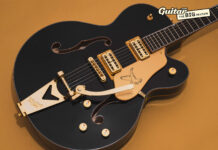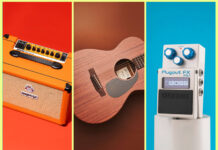
The best guitar pedals to buy in 2021: 17 best reverb pedals
The light of your amp’s reverb is fading. You yearn for something bigger, and so you plan to depart the mortal shores of onboard spring tanks for the undying lands of reverb pedals.
READ MORE: The best electric guitars to buy in 2021: 10 best baritone guitars
Here, your reverb trails may be infinite, they may be modulated and they may even have support for nine presets, more if you use MIDI. The journey will be long, perilous and potentially quite expensive, but this guide to the best reverb pedals out there should make it easier.
Why use a reverb pedal instead of amp reverb?
When amplifiers have onboard reverb, it’s most often either a spring reverb tank or a set of digital algorithms. Both of these have limitations: switching the reverb on or off with a footswitch isn’t always possible, and control over the sound is limited to one, maybe two, knobs.
READ MORE: How to build your own spring reverb unit
Moving over to a reverb pedal opens many more sonic options, from recreations of, and improvements on, old-school plate, hall and spring sounds, to wild, characterful and creative effects.
Where in the signal chain do you place the reverb pedal?
Reverb pedals raise an interesting question, to which there is no right answer: where do you put them in your signal chain?
Aside from your own experimentation, the biggest factor in answering this is the sound of your amplifier. Does it have heaps of headroom, or are you pushing its preamp section into natural overdrive?
If the former, then a reverb pedal should have enough room to breathe when placed between your guitar and your preamp. If the latter, you’ll get the cleanest sound from a reverb pedal when it’s in your effects loop – that is, after your preamp section and before your power amp section. If you don’t have an effects loop and you still want a clean reverb sound from a pedal, consider lowering your preamp gain, making up the difference with a dirt pedal.
That’s not to say that ‘clean’ is the only way to do things. Placing a reverb pedal before a distorting preamp section, much like placing one before a distortion, overdrive or fuzz, can have its own unique sound, one closely associated with shoegaze and post-rock.
The best reverb pedals to buy in 2021 at a glance
CBA Automotone CXM 1978
Strymon Nightsky
EQD Afterneath V3
Walrus Mako R1
Eventide Blackhole Standalone
EHX Oceans 12
EQD Astral Destiny
Keeley Caverns Delay Reverb V2
Fender Tre-Verb
Meris Mercury7
Anasounds Spring Reverb
Boss RV-6
TC Electronic Hall Of Fame
Strymon BigSky
Neunaber Immerse Reverberator
MXR M300 Reverb
Free The Tone Ambi Space
Chase Bliss Audio and Meris Automotone CXM 1978
+ Versatile, expansive and beautiful sounds+ What you see is always what you get– Expensive
The CXM 1978 is the second pedal to have Chase Bliss Audio’s Automatone form factor – that is, a wedge-shaped enclosure with motorised sliders. The crux of the pedal is a recreation of early digital reverb; it’s based on studio reverbs first heard in, you guessed it, 1978.
The result is a set of startlingly huge sounds and an even more startling amount of control. The bass and treble sliders, rather than controlling those frequencies’ presence in the mix, actually change separate decay times for each band. The location of each band can be adjusted, as can the pre-delay, overall mix and treble content – along with a number of other tweaks to the reverb algorithm’s workings.
From hi-fidelity perfection to strange, lo-fi soundscapes, the CXM 1978 really does do it all, and even though it offers massive amounts of digital save-and-recall action, thanks to those motorised sliders what you see is always what you get.
Unsurprisingly, all of this comes at quite a price – it’s certainly not a beginner’s pedal – but for some, the sounds will be more than worth it.
Price: $899/£875 Description: Studio-style plate reverb with adjustable clock rate, preset support and motorised sliders Controls: Decay time for midrange and bass, bass and midrange crossover point, pre-delay, reverb mix, independent preset recall footswitch Bypass: True bypass Mono or stereo: Stereo
Read our full review here.
Strymon NightSky
Image: Strymon+ Highly tweakable ambient sounds+ Full MIDI support– Expensive
It’s safe to say that if a pedal calls itself ‘a reverberant synthesis workstation and hands-on experimental sound design platform’, then you’re in for some massive, stereo ambience that evokes the hugeness of, well, the night sky.
This big blue box from Strymon is loaded with three core reverb textures, each of which can all be modulated with tape-esque pitch wobbles, reverberant LFO sounds or wah-like filter sweeps to the tune of five different waveforms, or an envelope that follows your playing dynamics.
A pitch-shifted shimmer voice can either add ethereal sparkle or an intimidating rumble. In fact, the shimmer section has a full selection of intervals to choose from, meaning you can shift your trails up or down by a second, fourth, fifth or octave.
Notably, there are separate controls for the wet and dry signals, and the ability to morph between two completely different sounds via an expression pedal. MIDI support also opens up 300 presets in total, or alternatively eight accessible via illuminated buttons on the pedal’s face.
Price: $429/£439 Description: Multi-function ambient delay with recallable presets and a variety of modulation modes Controls: Modulation speed, type, depth, waveform shape, low-pass and high-pass filters, pitch-shift interval, shimmer mix, reverb mix, dry mix, Bypass: True bypass Mono or stereo: Stereo
Read our full review here.
EarthQuaker Devices Afterneath V3
+ Unique core sound+ Flexible expression/CV support– Traditional reverb sounds are hard to conjure
The latest version of EQD’s Afterneath uses a tried and tested digital reverb algorithm that’s chock full of ethereal spaciness and pitch-shifting oddness – but with a few extra additions.
The pedal’s big selling point is the interaction between the Mode control and the Drag control, with the former adjusting the latter’s behaviour. The Drag control, now adjustable via an expression pedal, sweeps your reverb trail up through a certain set of pitches. The Mode control introduces varying amounts of quantisation, meaning you can have completely smooth drifting all over the place, or some arpeggiation locked to a certain scale.
It’s no ordinary reverb sound, but a healthy amount of controls means you can tame things before your pitch-shifted trails completely eclipse your playing. And if that’s precisely what you want, there’s a good chance you’ve already put the Afterneath V3 in a cart by this point.
Price: $199/£199 Description: Pitch-drifting reverb made of cascading delays with support for expression and CV control over pitch Controls: Length, diffuse, dampen, reflect, drag (pitch drift), mix Bypass: True bypass Mono or stereo: Mono
Read our full review here.
Walrus Mako R1
Image: Walrus Audio+ Massive range of sounds+ Compact compared to some digital reverb workstation– Not what-you-see-is-what-you-get
Walrus Audio‘s Mako series is something of a Goldilocks pedal. While this stereo reverb stompbox has all the trendy high-end bells and whistles – stereo support, huge present banks and powerful signal processing – it’s quite compact and rather fetching in its stepped enclosure. It even packs in a tap-tempo footswitch. Not bad for a pedal that measures less than 8cm across.
READ MORE: Colt Westbrook on Walrus Audio’s game-changing new Mako Series
At its core are six reverb sounds: three traditional, three less so. The spring, hall and plate reverb all offer hi-fi recreations of the classic types. The other three ( BFR, Refract and Air) are all better suited for soundscapes.
Also handy for soundscape purposes: delay time that can extend effectively forever (or, literally forever, if you use the infinite press-and-hold footswitch), extensive modulation options, and how you can hide your note’s attack with the swell control.
Price: $349 /£319 Description: Digital multi-mode stereo reverb pedal with presets Controls: Decay, swell, dry/reverb mix, modulation rate/depth/pre-delay switch with tweak knob, EQ low/high/X switch with tune knob, preset bank A/B/C switch, six-way rotary programme switch; bypass and sustain/latch footswitches Bypass: True Bypass Mono or stereo: Stereo
Eventide Blackhole Standalone
Image: Eventide Audio+ Can be the start of a stereo signal chain+ Wide range of ambient tones– You might already have an H9
A standalone version of the Blackhole algorithm found on Eventide’s famed H9 and H9000 multi-effects processors, this pedal’s name should give you an indication of spatial tones it offers up.
Its voice is unapologetically modern, but that’s not to say it can’t do slightly more ‘vintage’ sounds. The Size knob, at lower settings, will happily give you some room reverb tones that almost resemble slapback delay sounds. But when increased beyond the nine-o-clock mark, things start to get big, with sprawling trails that evoke the pedal’s namesake.
A reverb sound that massive can quickly become unwieldy; lucky you have a few tools at your disposal to keep your signal tidy. Firstly, there’s Gravity, which adjusts the attack of the reverb sound, meaning it can attack with immediacy or bloom in behind your playing. To keep your dry and wet signals more separate, you’ve also got high- and low-pass filters, as well as the option to adjust these filters’ resonance for even more experimentation.
Speaking of experimentation, the Mix knob allows you to completely kill your dry signal – allowing for completely transformative, cello-like sounds and even more abstract soundscaping.
The pedal’s also firmly in the ‘workstation’ category, with five onboard presets, and 127 accessible via MIDI. An expression pedal can also blend between heel and toe presets for smooth transitions, or just some inspiring, unexpected sounds.
Price: $199/£279 Description: Standalone version of Eventide’s Blackhole reverb algorithm Controls: Mix, Gravity, Feedback, Reverb Size, low- and high-pass filter, freeze footswitch, preset recall function, secondary deep editing Bypass: True bypass Mono or stereo: Mono input, stereo output
Electro-Harmonix Oceans 12
+ Extensive controls and I/O+ Affordable way to access huge number of sounds– Could cause option paralysis
The EHX Oceans 12 adds a few extra controls and features to its predecessor, the Oceans 11, which is already an absurdly feature-packed little pedal. It’s billed as a “dual stereo reverb”, meaning that housed within its bigger enclosure are two reverb engines – both are completely stereo and can be run in series or parallel.
The Oceans 12 also has stereo inputs and outputs, so it should slot happily anywhere into an existing stereo rig. It can, of course, function fine in mono, too. There’s even an effects loop to add in more effects to the mix.
The biggest appeal of the Oceans 12 is the sheer number of options available. There are 12 core reverb sounds – most of which have two modes, some three – and then there are two reverb engines at work. The tones themselves range from drippy spring reverbs to shoegaze-friendly reverse reverbs to huge shimmering ambience. If you’re indecisive about the reverb tone you need at your feet, then the Oceans 12 keeps your options open.
Price: $237.60/£229 Description: Stereo reverb pedal with 12 core sounds and two independent sound engines Controls: Effect level, pre-delay, decay time and tone knobs, reverb type selector, two controls specific to each type, switchable trails, mode selector switch Bypass: Buffered bypass Mono or stereo: Stereo
EarthQuaker Devices Astral Destiny
Images: Earthquaker Devices+ Multitude of takes on the shimmer concept+ Stretch footswitch and expression pedal let you get weird– Not for those who don’t like octave reverbs
This reverb is based around the shimmer sound – that is, when reverb trails are shifted an octave up or down. Per EQD fashion, however, there’s some weirder stuff at play here with several modes for a variety of reverb voices as well as in-built chorus modulation. The voices range from standard octave up or down shimmers, to stranger things such as the Astral mode, which cascades your pitch-shifted trails into themselves for blooming, chaotic ambience.
It’s versatile enough as a ‘set-and-forget’ sound to add some pitch-shifted ambience to your sound. But with the momentary Stretch footswitch, you can suddenly double the decay time of the reverb and thus warp the pitch of your repeats, an effect that’s highly interactive depending on the mode you’re in.
An expression pedal can also be mapped to either length, tone, mix or modulation depth or rate for even more interactivity.
The Astral Destiny’s focus on one style of reverb is both a pro and a con – while it might not cover the same reverb ground as a multi-reverb stompbox (no old-school spring sounds here), it dives deep into its sound niche and discovers some exciting, cosmic sounds.
Price: $199/£205 Description: Shimmer reverb with presets, modulation, and variety of pitch-shift modes and analogue dry-signal path Controls: Preset and mode selector knobs, depth, rate, tone, mix and length knobs, stretch footswitch Bypass: True bypass Mono or stereo: Mono
Keeley Caverns Delay Reverb V2
+ Both delay and reverb have fantastic core sounds+ Versatile modulation options from both– The delay is focused on analogue tape-echo rather than massive digital ambient sounds
Delay and reverb are a great combo, and so it’s no surprise that Keeley’s Caverns, which combines them both into one versatile stompbox, has become one of the brand’s most celebrated pedals.
READ MORE: Robert Keeley on his career switch from engineering professor to star pedal maker
The delay side of things offers a modulated tape echo style, although the modulation is totally optional and quite tweakable. There’s a rate knob for the speed of the modulation, and a toggle switch to choose between two different depths – or turning it off entirely. There are also controls for time, mix and repeats, with the latter being able to push the pedal into self-oscillating bliss.
The reverb side also has a toggle switch for choosing between a modulated reverb sound, spring reverb or shimmer. Handily, the modulation is appropriate to each style. The old-school spring reverb sound offers a suitable Fender black-panel-style tremolo, the modulated reverb offers adjustable chorus ambience, and the shimmer style lets you tweak how ‘fed-back’ its octave-up voice is.
The reverb side also has a dedicated warmth knob to keep the wet signal from stomping all over your playing. Both sides of the pedal can be activated independently, with their respective blend knobs keeping things balanced. If you want something slightly more out there, but don’t want to lose traditional sounds – in both the worlds of delay and reverb – the Caverns is a great choice.
Price: $179/£189 Description: Dual delay and reverb pedal with independent switching Controls: Reverb type, blend, warmth, modulation rate and decay time, Delay blend, time, modulation rate, repeats, and modulation amount. Bypass: Switchable true-bypass or trails Mono or stereo: Mono
Fender Tre-Verb
+ Authentic Fender amp-style reverb and tremolo+ Versatile signal path switching– Not for ambient guitarists
When you think of the combination of tremolo and reverb, you’re likely thinking of the sound of a classic Fender amp. So who better to combine these effects into a pedal than Fender itself?
The pedal is straightforward yet versatile. The tremolo and reverb circuits are independently switchable, with tap tempo on the tremolo side to adjust its rate. The reverb side has three voices: two spring reverb emulations from 1963 and 1965 amplifiers, and one plate reverb emulation. Controls allow adjustment of the overall mix, reverb time and importantly tone, so the treble of your sound doesn’t become busy.
The tremolo side is no afterthought, either, with a switch for selection between optical, harmonic and bias modes, and depth, level and rate knobs. Handily, you can also change the order of effects – tremolo before reverb, or vice-versa.
While it won’t be for those looking to sculpt 20-minute-long cascading octave trails, there’s no better pedal for emulating the effects section of an old-school amp.
Price: $299.99/£199 Description: Dual tremolo and reverb pedal with old-school analogue-style emulations of both Controls: Tremolo rate, depth, level and type; reverb blend, tone dwell and type Bypass: True bypass Mono or stereo: Stereo
Meris Mercury7
+ Offers two great but different styles of massive reverb+ Hidden features are a nice bonus– Not too many options for “traditional” reverb sounds
The Mercury7 has a space-related name, so it’s no surprise that it’s offering up some galactic-sized ambience. In this case, the reverb space comes in two flavours: Ultraplate and Cathedra. The former has a fast attack but a more understated size and frequency character. That means it still sits as a lush, spongy layer beneath your tone.
Cathedra, on the other hand, has a much more present ‘architectural’ character, rather than Ultraplate’s abstract one. It’s got a slower attack to reflect the size of an actual space. And for further tweaking and balancing there’s a set of low- and high-pass filters.
Pitch-shifting can be applied to the trails, ranging from sub-octave to shimmer sounds, as well as slow drifting up or down. There’s a separate LFO-operated modulation onboard for more wobble, as well as a host of hidden features accessible via the alt-footswitch. The latter also doubles up as a way to suddenly max out decay time, or to engage auto-swell mode for hiding your note’s attack.
It’s perhaps refreshing to see this much power and tweakability applied to a pared-down selection of two core voices. If pedals like the Oceans 12 give you option paralysis, but you’re looking for something more outre than a spring-reverb-in-a-box, the Mercury7 strikes a great balance.
Price: $299/£299 Description: Digital reverb with two modulated and pitch-shifted voices Controls: Space decay, modulation, reverb mix, low- and high-pass filters, pitch-shift mode selector, swell footswitch Bypass: True bypass Mono or stereo: Mono input, stereo output
Anasounds Element Spring Reverb
+ True analogue sounds, no algorithms go near your tone+ Modular design– Costly and potentially unwieldy
Speaking of spring-reverb-in-a-box, that’s precisely what Anasounds’ Element Spring Reverb is. More accurately, it’s a spring reverb in a pedal plus one of three sizes of spring reverb tanks, connected via stereo RCA. These tanks contain, well, actual springs – a true analogue way of achieving old-school amp-style reverb.
The pedal, which needs to be connected to one of the tanks to function, offers controls for low and high frequencies, wet-dry mix, as well as overall output. There’s a toggle switch to engage Spring Saturation mode, which overdrives the reverb signal to create a unique distorted reverb tone. But overall, it’s pretty straightforward, putting very few things in between you and the actual spring tanks. As the tanks and the core pedal are separate, you can mount the tank underneath your pedalboard for more space, or keep it on top for easy kicking.
The Anasounds device effectively adds the controls that some players wish their amp’s built-in spring reverb had – and the choice of three sizes may be a bit of a roundabout way to achieve a longer decay time. For analogue purists, it’s spring heaven.
Price: €359 for the ‘premium’ package featuring the pedal and all three spring tanks Description: Analogue reverb pedal that uses one of three outboard spring reverb tanks Controls: Two band EQ, wet-dry mix, output level and switch for ‘saturated’ reverb mode Bypass: True bypass Mono or stereo: Mono
Boss RV-6
+ Both ambient and traditional bases covered+ Versatile I/O and analogue-dry-through– Not too much deep editing on offer
Fitting into Boss’ famed compact form factor, the RV-6 offers a huge number of features for its size and price. Similar to the Oceans 12, it’s packed with a huge range of core sounds, from spring and plate emulation to modulated and shimmer reverbs. These sounds can be tweaked via level and tone controls, which is great if you just want a variety of sounds straight out of the box.
The RV-6 should also pique the interest of wet-dry-rig enthusiasts for two reasons. Firstly, the pedal remains completely analogue dry-through, so no phase issues should arise if you’re using two amps. And secondly, by using just the ‘B’ input, the pedal outputs a 100 per cent wet signal, meaning it can slot happily into more complicated rigs.
Price: $153.99/£149 Description: Stereo reverb with mode switch for 10 algorithms in total Controls: Reverb mode selector switch, time, mix and tone knobs Bypass: Buffered bypass Mono or stereo: Stereo
TC Electronic Hall Of Fame 2
+ Affordable and straightforward+ One of the most accessible stereo pedals out there– Not much deep editing without going into TonePrint territory
It may not be the most glamorous or ‘boutique’ reverb out there, but there’s a good reason the TC Electronic Hall Of Fame can be found on the boards of beginner and pro players alike the world over – and it’s not just the price.
In this red box, you get a full range of sounds, all the way from the standard hall, spring and plate emulations to modulated, lo-fi and generally more ambient tones. These 10 sounds are adjusted by decay and tone knobs, as well as a small toggle switch for a long or short pre-delay.
Like the RV-6, the Hall Of Fame is a great option for players who just want a wide range of sounds and a basic degree of tweaking. For more advanced players, there is the option to import algorithms via TC Electronic’s TonePrint tech.
Price: $99/£99 Description: Stereo reverb pedal with multiple modes Controls: Reverb mode selector, tone, level and decay knobs, toggle switch for pre-delay Bypass: True bypass Mono or stereo: Stereo
Strymon BigSky
+ Achingly beautiful ambient tones+ Stereo is used well to create massive space– Expensive
The BigSky is another reverb pedal staple, and for good reason. It offers 12 reverb types, with the stalwart spring, plate and hall sound well catered for. Where it’s found the most favour, however, is in its proprietary ambient sounds, such as Bloom, Chorale and, especially, Cloud.
These extremely tweakable sounds are fine-tuned for enormous ambience, creating synthesiser-pad-like drones and airy highs that make full use of the pedal’s stereo support.
With the number of MIDI presets and depth of controls, it’s certainly a reverb for those serious about their sound. It’s the reverb nerd’s reverb pedal, one which you might find yourself lost in. The price tag certainly reflects this, but given how ubiquitous it is across pedalboards everywhere, the Strymon BigSky has certainly earned its reputation.
Price: $479/£449 Description: Stereo reverb with preset support and 12 reverb voices Controls: Decay, predelay, mix, tone and modulation knobs as well s two parameters that depend on the current reverb voice Bypass: True bypass Mono or stereo: Stereo
Neunaber Immerse Reverberator MkII
+ Immersive stereo sounds+ Intuitive multi-function controls– No MIDI
The second version of Neunaber’s Immerse Reverberator promises, well, more immersion thanks to a few tweaks. Notably, you can now kill your dry signal, and the pedal’s algorithms have been updated for a more spacious sound. Two of the pedal’s knobs vary their function depending on the selected algorithm, resulting in a massive range of sounds to explore and tweak.
The pedal’s stereo support is made full use of, with the algorithms able to convert a mono signal source into stereo. Equally, it will slot happily into a full stereo rig thanks to its stereo ins and outs.
While the pedal’s sound skews more ambient, the traditional sounds are not abandoned, with aspiring, hall and plate reverbs all making a cameo appearance among shimmers and infinite sustain sounds.
Price: $239/£249 Description: Stereo reverb pedal with multiple modes, focusing on ambient depth Controls: Mix and depth dedicated knobs, multi-function pre-delay / modulation / blend and time / tone knobs Bypass: True or buffered (trails) bypass Mono or stereo: Stereo
MXR M300 Reverb
+ Present-blending with an expression pedal+ Healthy balance between ambient and traditional– Not as many options as some pedals
The M300 is a reverb pedal proudly bearing MXR’s straightforward approach to effects. The stompbox sports a simple three-knob configuration, with the tone knob also allowing you to cycle through six algorithms from plate, spring and room to the more esoteric Mod, Epic and Pad modes – a good 50/50 split of traditional and ambient sounds.
Notably, an expression pedal can be used to blend between two completely different sounds, modifying all three controls at the same time – great for smooth transitions or finding a unique tone.
Price: $199.99/£219 Description: Multi-function reverb with six modes: three traditional and three ambient Controls: Reverb decay, mix and tone Bypass: True or buffered (trails) bypass Mono or stereo: Mono
Free The Tone Ambi Space AS1R
+ Focuses on doing a few things well+ Massive stereo sounds and extensive I/O– Expensive
Free the Tone has been making waves for its no-nonsense pedals that issue out pristine, as-they-should-be tones. And the Japanese brand’s reverb unit, the Ambi Space AS-1R, does exactly that. What it lacks in features it more than makes up for with stunning, studio-grade reproductions of the four common reverb types: spring, plate, room and hall.
These are the reverb equivalent of the best burger you’ve ever wolfed down. Not the most exciting meal, but it impresses for doing something so simple so well. These four modes are some of the most non-intrusive, natural-sounding we’ve come across in pedal format, from the subtle nuances of the plate ’verb to the lush hall.
Price: $380/£359 Description: MIDI-enabled digital reverb with preset recall and six core voices, four traditional and two ambient Controls: Mix, tone, decay and pre-delay, mode selector, preset footswitch Bypass: True Bypass Mono or stereo: Stereo
For more buyers’ guides, click here.
The post The best guitar pedals to buy in 2021: 17 best reverb pedals appeared first on Guitar.com | All Things Guitar.
Source: www.guitar-bass.net










